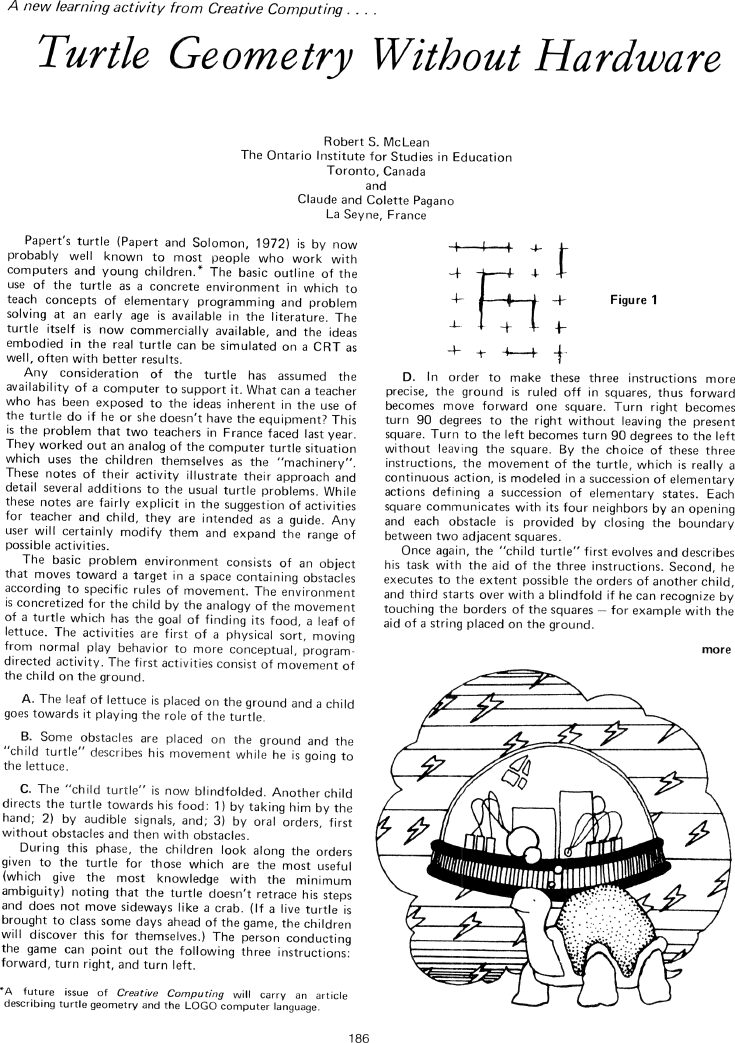The Best of Creative Computing Volume 1 (published 1976)
Turtle Geometry Without Hardware (Papert's turtle with children as turtles)

A new learning activity from Creative Computing.…
***
Turtle Geometry Without Hardware
***
Robert S. McLean The Ontario Institute for Studies in Education Toronto, Canada
and Claude and Colette Pagano La Seyne, France
***
Papert's turtle (Papert and Solomon, 1972) is by now probably well known to most
people who work with computers and young children.* The basic outline of the use
of the turtle as a concrete environment in which to teach concepts of elementary
programming and problem solving at an early age is available in the literature.
The turtle itself is now commercially available, and the ideas embodied in the
real turtle can be simulated on a CRT as well, often with better results.
***
Any consideration of the turtle has assumed the availability of a computer to
support it. What can a teacher who has been exposed to the ideas inherent in the
use of the turtle do if he or she doesn't have the equipment? This is the
problem that two teachers in France faced last year. They worked out an analog
of the computer turtle situation which uses the children themselves as the
"machinery". These notes of their activity illustrate their approach and detail
several additions to the usual turtle problems. While these notes are fairly
explicit in the suggestion of activities for teacher and child, they are
intended as a guide. Any user will certainly modify them and expand the range of
possible activities.
***
The basic problem environment consists of an object that moves toward a target
in a space containing obstacles according to specific rules of movement. The
environment is concretized for the child by the analogy of the movement of a
turtle which has the goal of finding its food, a leaf of lettuce. The activities
are first of a physical sort, moving from normal play behavior to more
conceptual, program-directed activity. The first activities consist of movement
of the child on the ground.
***
A. The leaf of lettuce is placed on the ground and a child goes towards it
playing the role of the turtle.
B. Some obstacles are placed on the ground and the "child turtle" describes his
movement while he is going to the lettuce.
C. The "child turtle" is now blindfolded. Another child directs the turtle
towards his food: 1) by taking him by the hand; 2) by audible signals, and; 3)
by oral orders, first without obstacles and then with obstacles.
***
During this phase, the children look along the orders given to the turtle for
those which are the most useful (which give the most knowledge with the minimum
ambiguity) noting that the turtle doesn't retrace his steps and does not move
sideways like a crab. (lf a live turtle is brought to class some days ahead of
the game, the children will discover this for themselves.) The person conducting
the game can point out the following three instructions: forward, turn right,
and turn left.
***
*A future issue of Creative Computing will carry an article describing turtle
geometry and the LOGO computer language.
***
[Image] Figure 1
***
D. In order to make these three instructions more precise, the ground is ruled
off in squares, thus forward becomes move forward one square. Turn right becomes
turn 90 degrees to the right without leaving the present square. Turn to the
left becomes turn 90 degrees to the left without leaving the square. By the
choice of these three instructions, the movement of the turtle, which is really
a continuous action, is modeled in a succession of elementary actions defining a
succession of elementary states. Each square communicates with its four
neighbors by an opening and each obstacle is provided by closing the boundary
between two adjacent squares.
***
Once again, the "child turtle" first evolves and describes his task with the aid
of the three instructions. Second, he executes to the extent possible the orders
of another child, and third starts over with a blindfold if he can recognize by
touching the borders of the squares - for example with the aid of a string
placed on the ground.
***
more
***
186


